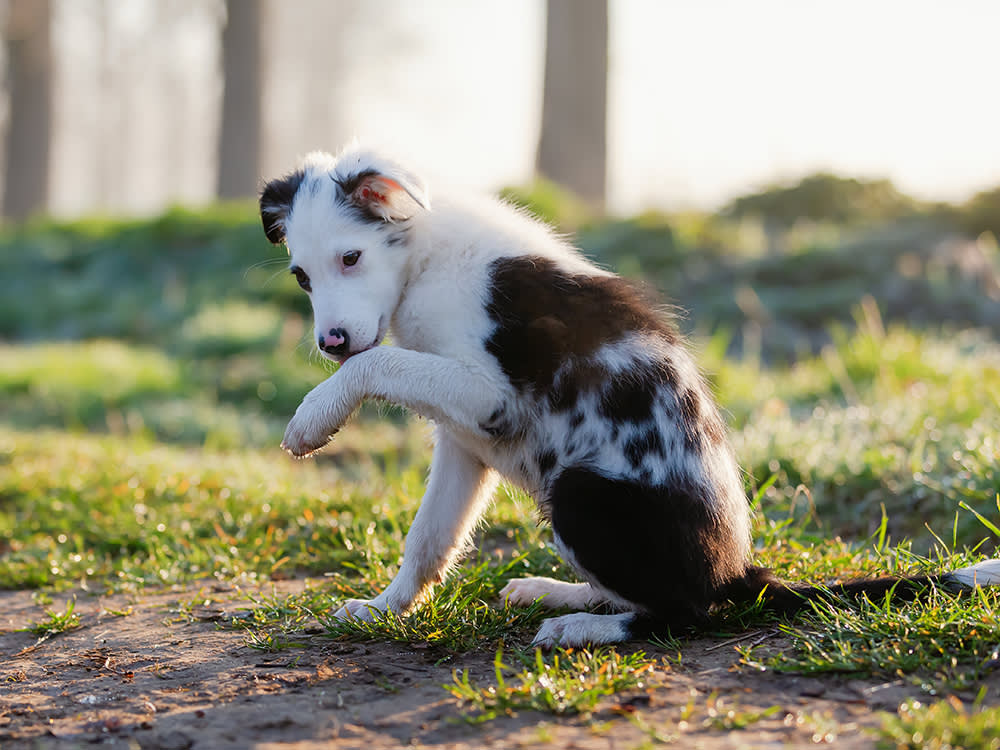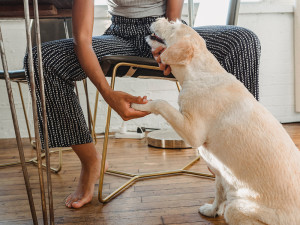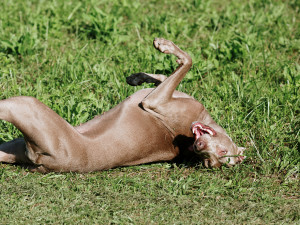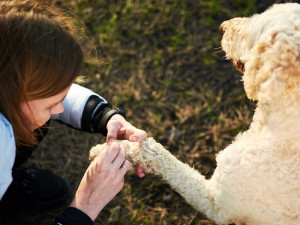Hot Spots on Dogs: Causes, Symptoms, and Treatment
Unfortunately, this term refers to a “summer sore,” not a club coveted by SNL’s Stefon.

share article

Your pet wants you to read our newsletter. (Then give them a treat.)
In This Article:
What Are Hot Spots?opens in a new tab What Causes Hot Spots? opens in a new tabSymptoms of Hot Spots on Dogsopens in a new tab How to Treat a Dog’s Hot Spotsopens in a new tab at Home How to Prevent Hot Spots on Dogsopens in a new tab When to Take Your Dog to the Vet for Hot Spotsopens in a new tab
Hot spots on dogs are areas of inflamed, moist skin that can be caused by a variety of factors, including allergies, parasites, and injuries. Symptoms of hot spots include red, itchy skin, hair loss, and a foul odor. Treatment for this condition typically involves clipping the hair around the affected area, cleaning the wound, and applying an antibiotic spray or other medications.
What are hot spots on dogs?
A hot spot, referred to by vets as moist dermatitis or pyotraumatic dermatitis, is a common infection that happens when dogs chew, scratch, lick, and gnaw at themselves, allowing the skin’s normal bacteria to grow out of control. In the first stages of formation, the skin becomes moist, red, itchy, and infected. Pus begins to ooze from the traumatized skin as infection sets in. Then, dried pus and damaged skin will work to form a tightly adhered crust. Hair loss over the infection site often follows. The development of moist dermatitis can be a very painful process, and frequently, dogs will show pain when the area is touched.
Dogs are their own worst enemies when it comes to hot spots, which are generally created by their own overzealous self-licking and chewing. Hot spots can arise surprisingly quickly: A few minutes of “work” can create some serious self-inflicted trauma. The good news is that hot spots almost always look worse than they actually are, and infection is usually superficial — often resolved by topical treatment alone.
What causes hot spots on dogs?
So, what causes dogs to begin chewing and licking in the first place? Good question. The answer is anything that creates irritation, which includes things like:
Insect bites (fleas, flies)
Skin allergies
Excess skin-surface moisture
Naturally heavy or dense coats
Matted hair
Saliva accumulation under the fur (read: the pet who’s always licking their feet)
Abrasions
Excessive humidity in the environment
Hot spots can even be caused by a dog’s good old-fashioned boredomopens in a new tab. The location of the hot spots may help your veterinarian determine their underlying cause. For example, a hot spot over the hip area could indicate flea infestation, hip arthritis, or an anal gland infection. Similarly, a hot spot near an ear could indicate an ear problem, an allergy, dental issues, or nerve irritation.
What are the symptoms of hot dogs on dogs?
Dog parents are often shocked by how quickly a hot spot can progress. Dogs will often go from having no visible skin problems to having a rapidly spreading skin infection within a couple of days. Some common symptoms of hotspots on dogs to watch for include:
Excessive chewing or scratching
Moist or matted appearance to an area of hair
Foul odor
Pain
Hair loss
Red, inflamed skin
What do hot spots on dogs look like?
The appearance of a hot spot on a dog will depend on how early it’s caught. Hot spots start off as a damp area of hair with inflamed skin beneath. As the lesion matures, the discharge oozing from the skin will harden in the hair and create a crust over the inflammation.
This crust also traps moisture in, keeping the environment ideal for bacteria to grow. This allows the infection to spread to surrounding skin quickly. As they progress, hot spots will lose the hair in the center of the skin, due to a combination of self-trauma (chewing) and injury to the hair follicles.
How to treat your dog’s hot spots at home
If the dog’s hot spot is small, non-painful, recognized early, and uncomplicated, it may be possible to begin treatment at home with over-the-counter products such as topical sprays, medicated shampoos, herbal therapies, and more. The important thing is to ensure that you’re using a pet-safe product, in which case it never hurts to call your veterinarian for approval.
Whatever you do, do not use human topical products, as they may be toxic to dogs when licked and ingested. For example, zinc oxide, which is often found in human skin ointments, can be toxic for pups. Here are some at-home treatment basics:
If the area is small and non-painful, carefully and gently clip the fur that is covering the area; this allows air and medication to reach the wound. (Word of caution: Use approved grooming clippers, not scissors. I see many “accidental lacerations” in the ER because of this.) If your dog seems to be in pain during this, stop and call your vet.
Keep your pet from licking the area. You guessed it, get out that cone of shame.
Apply a warm, moist compress to the area three times daily for five to 10 minutes to keep the area clean, calm the tissues, and encourage good circulation. Allow the area to fully dry before applying anything topically.
Use only pet-safe, veterinary-approved, over-the-counter treatments. As always, it is best to consult with your veterinarian prior to starting any home treatment.
Do not place any bandages or wraps to cover the area — you want the area to “breathe.”
Alleviate the itching or irritation that started the whole thing in the first place — get to the bottom of the source. Otherwise, you’ll be faced with a losing battle.
Tips for preventing hot spots on dogs
One of the things that can’t be stressed enough is appropriate flea control. Good flea control is important for any itchy pet and is the foundation of “itch prevention.”
In hot, humid weather, always thoroughly dry your heavy-coated dog after bathing or swimming. Make sure their collar and hair beneath it is dry too, hot spots love to develop in damp, covered areas.
Make sure your dog is groomed on a regular basis.
Keep boredom and stress at bay — provide adequate exercise and opportunities for mental stimulation and play.
Talk to your vet about introducing essential fatty acids to your pet’s diet to help keep a healthy coat.
If your dog has allergies, work with your vet to keep allergy symptoms under control.
When it’s time to see a vet
The bad news is that about 30 percent of pets who develop hot spots actually have some other kind of skin disease, such as a deeper skin infection, a bite wound, or even immune-mediated disease. If you have any concerns whatsoever, it’s best to have your veterinarian assess your dog’s skin. Veterinary intervention may also be needed when the hot spot becomes so big and painful that it requires sedation to be properly clipped and cleaned.
A hot spot can be accompanied by a deeper skin infection, which would require more extensive therapy such as oral pain medications, oral anti-inflammatory medications, and oral antibiotics in addition to topical treatments. The treatment your veterinarian chooses will depend on how bad the problem is, how much pain your dog is in, how long the problem has persisted, and if the problem is a recurring one. Some dogs may get one or two hot spots and then never get another one again (lucky them!), while others may have frequent recurrences.
How do vets diagnose hot spots?
Hot spots have a distinctive look and smell (unfortunately) that your vet will likely recognize on examination. Although they are often diagnosed based on appearance, your vet may want to do additional diagnostics if they suspect a particularly deep infection, if your dog has evidence of parasites or another trigger, or if your dog is having recurrent hot spots. Tests can include skin scrapes to look for parasites, bacterial cultures, or even skin biopsies. Most dogs with uncomplicated, infrequent hot spots are just treated based on symptoms alone.
What can vets prescribe to treat hot spots?
After vets diagnose a hotspot on a dog, treatment is usually pretty straightforward. After giving pain medication or sedatives, clipping the area, cleaning it with an antiseptic scrub, and drying it thoroughly, your vet will want to prescribe at-home treatment to make sure the hot spot resolves.
One of the most important steps is to stop your dog from further damaging the area. This generally means a cone and/or at-home sedatives to help discourage self-trauma. There have been a few studies that looked into how to soothe hot spots on dogs. A variety of medications can help with hotspots, and the goal is to give your pup relief while risking the fewest medication side effects. The mainstay of treatment is a combined antibiotic and steroid spray. This helps to kill the bacteria causing the infection and calm the inflamed skin in the area.
Hot spots that are very itchy or have evidence of deeper infection may require oral medications like antibiotics or steroids to get things under control quickly. They usually resolve well with basic treatments and most dogs feel better quickly after treatment begins.
Many dog parents want to help things along and wonder “what can I put on my dog’s hot spot to help things along.” While it’s tempting to try to add extra treatments to get your pup feeling better quickly, don’t be tempted to put things that your vet didn’t prescribe on the area. Creams and ointments hold in moisture, and any essential oil, chemical, or dressing can further irritate the damaged skin. Just give things a little bit of time and your dog should be feeling better in no time.
FAQs (People also ask):
How can I identify a hot spot on my dog?
Hot spots can be difficult to find early in their development. Look for signs, such as damp or greasy hair, pain, a foul odor, and excessive scratching or chewing to indicate that there may be a problem.
Should I shave the hair around my dog’s hot spot?
Using grooming clippers made for dogs to shave the hair helps to allow a hot spot to dry and begin to heal. Doing this at home may work for some very small hot spots, but most require veterinary care due to the pain and inflammation in the area.
Can hot spots be a sign of an underlying health issue?
Hot spots are often associated with an underlying skin disease. Dogs with hot spots may have health issues like skin parasites (fleas, lice, mange), allergies, hip pain, ear infections, or anal gland infections that trigger chewing and scratching.
Are there any breeds that are more prone to hot spots?
Studies have looked at which dog breeds tend to get hot spots most frequently. Some of the most common dog breeds that get these include Rottweilers, German Shepherds, and Golden Retrievers.
References:

Dr. Shea Cox, DVM, CVPP, CHPV
Dr. Shea Cox is the founder of BluePearl Pet Hospice and is a global leader in animal hospice and palliative care. With a focus on technology, innovation and education, her efforts are changing the end-of-life landscape in veterinary medicine.

Dr. Bartley Harrison, DVM
Dr. Bartley Harrison, DVM is a small animal veterinarian based in North Carolina who has practiced emergency medicine since graduating from the Texas A&M College of Veterinary Medicine. His primary interest areas include pain management, cardiology, and the treatment of shock.
He is a member of the Veterinary Emergency and Critical Care Society, American Veterinary Medical Association, and American Medical Writers Association. In addition to his clinical work, he writes pet health articles to help provide accurate information for both new and experienced pet parents. When he’s not working, he enjoys cooking, traveling, reading, and going on adventures with his dog.
Related articles
![a Chihuahua dog licking their paw]() opens in a new tab
opens in a new tabWhy Is Your Dog Obsessed With Licking Their Paws?
Their toes might smell like Fritos, but there’s no way they taste that good.
![A woman checking out her dogs paw.]() opens in a new tab
opens in a new tabKeep Your Dog Safe With These Tick Prevention Tips
Simple preventive steps can go a long way toward offsetting their threats
![]() opens in a new tab
opens in a new tabScared Stiff: How to Spot Tetanus in Dogs
Yes, dogs can get tetanus too — and not just from rusty nails.
![Dave looks down at his dog Stanley, with the sea and rock cliffs in the background.]() opens in a new tab
opens in a new tab5 Dog-Friendly Nature Spots around LA for Hiking, Camping & Zenning Out
LA wellness guru Dave Coastopens in a new tab shares his favorite places to escape the city with his Poodle.
![Labrador Retriever and Dachsund playing with a stick at the beach shoreline]() opens in a new tab
opens in a new tabSummer Is Heating Up. Here’s How to Keep Your Dog From Doing the Same
Pro tips to keep your pup safe, happy, and exercised during the warmer months.
![A man walks his dog Tuesday in New York City.]() opens in a new tab
opens in a new tabSmoke Is Engulfing NYC. Here Are Wildfire Safety Tips For Pets
As East Coast residents are aware, wildfire season is here. Take these steps to protect your pets.










